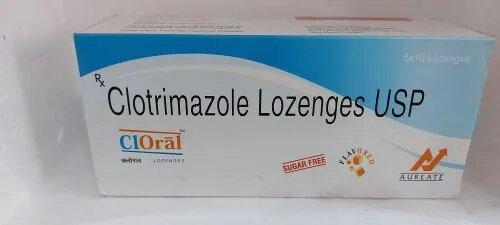Why is this medication prescribed?
Adults and kids aged three and older who have oral yeast infections are treated with clotrimazole lozenges. Also, it can be used to patients undergoing specific treatments who are at risk for oral yeast infections to prevent them. The antifungal drug clotrimazole belongs to a group of drugs called imidazoles. It functions by halting the development of infection-causing fungus.
How should this medicine be used?
When taken as a lozenge, clotrimazole slowly dissolves in the mouth. Usually taken five times daily for 14 days, it is used to treat yeast infections. It is frequently taken three times day to prevent yeast infections. Your condition will determine how long you need to receive treatment for preventive. Use clotrimazole lozenges daily at much the same times. Ask your doctor or pharmacist to explain any instructions on your prescription label that you are unsure about following. Follow the medication’s directions precisely. Use it only as directed by your doctor, neither more nor less often.
Place the lozenge in your mouth and let it slowly melt to use. Avoid swallowing, crushing, or chewing clotrimazole lozenges. It should dissolve in around 30 minutes.
Other uses for this medicine
Ask your doctor or pharmacist for more details if you believe this drug should be used for something else.
What special precautions should I follow?
Before using clotrimazole lozenges,
- If you have an allergy to clotrimazole, any other drugs, or any of the chemicals in clotrimazole lozenges, inform your doctor right away. Get a list of the components from your pharmacist.
- Inform your doctor and pharmacist about all prescription and over-the-counter drugs, vitamins, dietary supplements, and herbal products that you are now taking or intend to use.
- If you have liver illness now or previously, let your doctor know.
- Inform your physician if you are nursing a baby, intend to get pregnant, or are already pregnant. Call your doctor if you become pregnant while taking clotrimazole lozenges.
What special dietary instructions should I follow?
Keep eating normally unless your doctor instructs you otherwise.
What should I do if I forget a dose?
The missed dose should be taken as soon as you remember. If the next dose is soon due, skip the missed one and carry on with your regular dosing plan. To make up for a missing dose, do not take a second one.
What side effects can this medication cause?
There may be negative effects from clotrimazole. If any of these symptoms are severe or do not go away, let your doctor know right once:
- Nausea
- Vomiting
- Negative oral feelings
- Itching
Other adverse reactions to clotrimazole are possible. If you have any strange side effects while taking this medicine, contact your doctor right away.
You or your doctor can submit a report to the Food and Drug Administration’s (FDA) MedWatch Adverse Event Reporting programme online or by phone if you have a serious side event (1-800-332-1088).
What should I know about storage and disposal of this medication?
Keep this medication tightly closed in the original container and out of the reach of children. Keep it away from excessive heat and moisture at room temperature (not in the bathroom). Avoid freezing.
Although many containers (such as weekly pill minders and those for eye drops, creams, patches, and inhalers) are not child-resistant and are simple for young children to open, it is crucial to keep all medications out of sight and out of reach of children. Always lock safety caps and promptly stash medication up and away from young children where it is out of their sight and reach to prevent poisoning. http://www.upandaway.org
Unused prescriptions must be disposed of carefully to prevent pets, kids, and other people from ingesting them. You should not, however, dispose of this medication in the toilet. Instead, utilising a medicine take-back programme is the easiest approach to get rid of your medication. To find out about take-back programmes in your area, speak with your pharmacist or the garbage/recycling department in your city. If you do not have access to a take-back programme, see the FDA’s Safe Disposal of Medications website at http://goo.gl/c4Rm4p for additional information.
In case of emergency/overdose
Call the poison control hotline at 1-800-222-1222 in the event of an overdose. Moreover, information can be found online at https://www.poisonhelp.org/help. Call 911 right once if the person has collapsed, experienced a seizure, is having difficulty breathing, or cannot be roused.
What other information should I know?
Keep all of your appointments with your physician and the lab. To determine how well your body is responding to clotrimazole lozenges, your doctor may request specific lab tests.
Do not share your medication with anybody else. Once you’ve finished the clotrimazole, call your doctor if you continue to experience symptoms of infection.
You should keep a written record of every medication you take, including any over-the-counter (OTC) items, prescription drugs, and dietary supplements like vitamins and minerals. This list should be brought with you whenever you see a doctor or are admitted to the hospital. You should always have this information with you in case of emergencies.
Brand names
- Mycelex®


